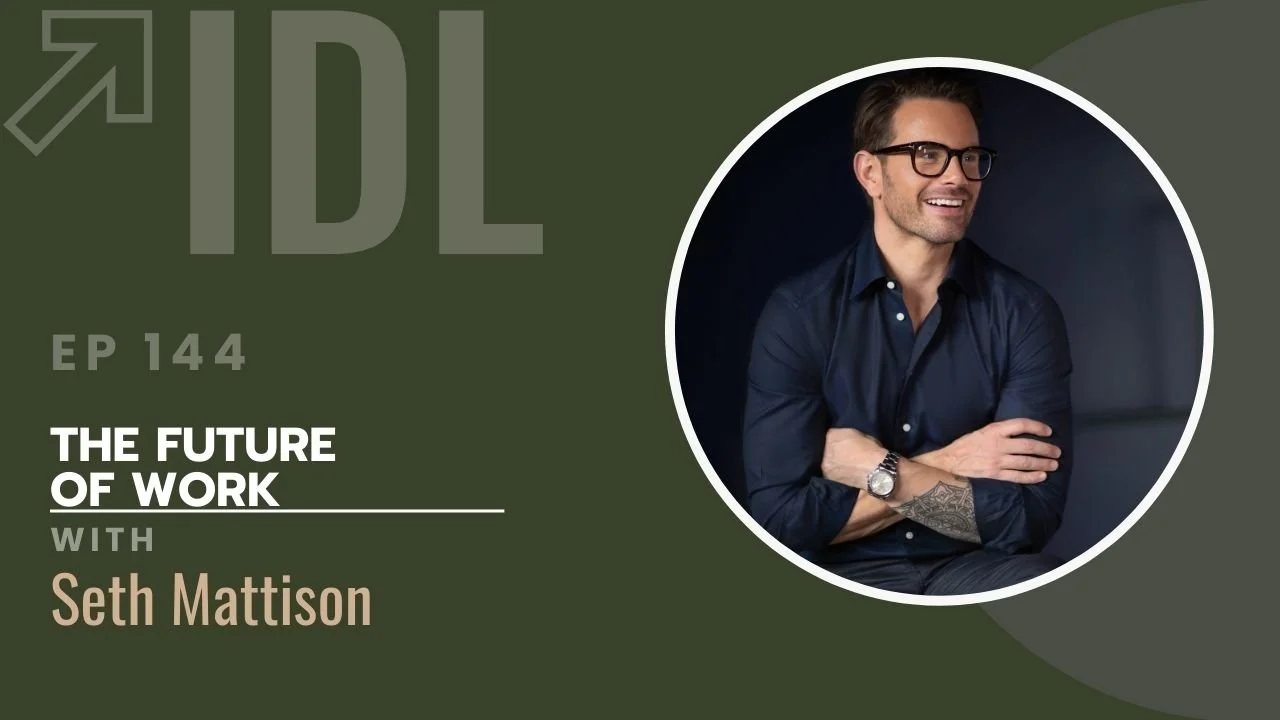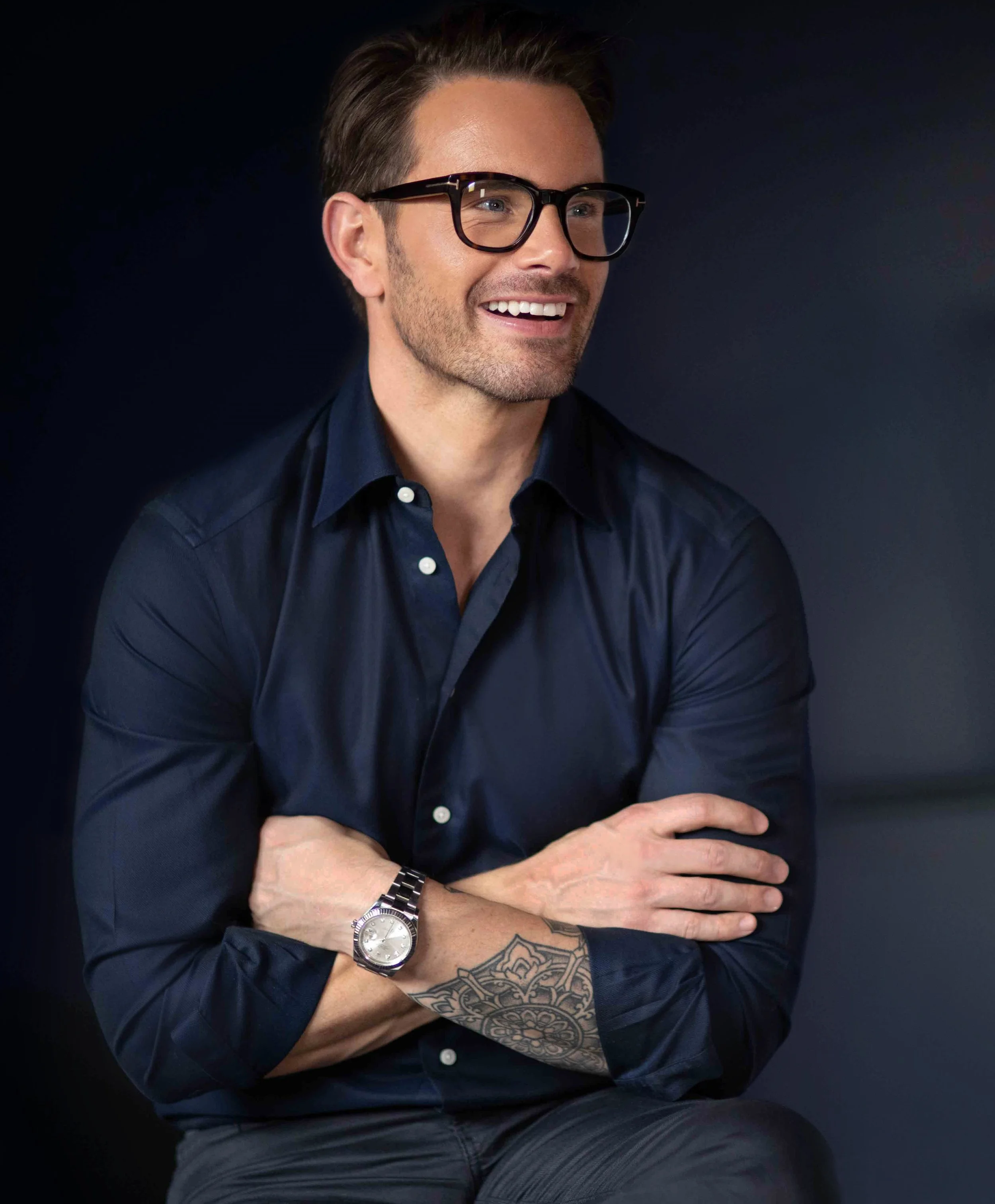IDL144 Season 3: The Future of Work with Seth Mattison
How can you test the strength of your leadership? What do you need to do to build psychological safety in your company? Can you navigate the change in a way that brings both your employees and your business out on top?
Hello and thank you for joining us! Today I’m interviewing Seth Mattison, a speaker, author, and leadership coach. Our conversation touches on a number of points. We look at how you can identify and resolve pain issues in the market, how to test and build psychological safety within your team, and how to adapt to a changing workforce.
Meet Seth Mattison
Seth Mattison is an internationally renowned expert, future of work keynote speaker, author, and business performance advisor. As Founder and CEO of the org design and transformation firm FutureSight Labs, keynote speaker and Seth advises many of the world’s leading brands and organizations on the key shifts happening around talent management, change and innovation, digital transformation, leadership, and the future of work.
He also coaches high-performing leaders with practical, life-tested ideas, concepts, and frameworks to elevate their impact and create lasting legacies.
Visit Seth’s website and connect on Facebook, Instagram, X (formerly Twitter), LinkedIn, and YouTube.
IN THIS EPISODE WE DISCUSS:
Notice a pain to serve a need - 06:30
Be willing to sacrifice for your dreams - 16:17
How leadership has critically changed - 20:57
How to test the strength of your leadership - 23:00
Building psychological safety in your team - 27:33
Navigating the change - 36:56
Notice a pain to serve a need
Each generation will face a different set of challenges and circumstances than those that came before it and will come after it. However, there’s a period of transition, and we’re in one of those now.
In those moments of change, there needs to be intentional communication for people to understand one another and work together in the best way possible, and to move forward as one instead of leaving each other behind.
“These executives were looking at me like, “What in the world are you going to tell me about leadership and culture change and leading transformation? You’re like the same age as my kid …” And so I felt all of that, and so to bridge the gap, I started asking them more specific questions about their younger workforce. ”
Seth noticed a pain point in the older executives that he was working with at the time who were struggling to connect with their younger employees, and were beginning to struggle to maintain a cohesive team since they couldn’t relate as well as they used to.
“I started asking them more specific questions about our collective generation’s impact on their culture, their ability to attract and retain, etc., and all of this pain, frustration, and angst came pouring out of every single client, no surprise, which there usually is when it comes to a new generation. ”
By noticing a pain point in the local and global community, an entrepreneur can begin to pinpoint exactly where a need that’s either unseen or unheard needs to be filled.
“You know when there’s a pain in the marketplace, there’s an opportunity, if you can bring a solution to that pain. ”
Be willing to sacrifice for your dreams
“Your dreams are going to cost something. To go [after] the work or the message that’s on your heart is going to require a deposit. A deposit of something, you’re going to have to give something up.”
The thing that you want and the work you want to create isn’t just going to come around because you asked for it nicely. You have to put in the effort to make it happen, to bring it to fruition.
They say that sometimes good things don’t come easy, and it’s true. Worthwhile things are hard earned because they wouldn’t be worthwhile if everyone could do them. If you want to go after something, then commit to it, and do it.
You may need to sacrifice your comfort, an older version of yourself, your old habits or beliefs, but it would be worth it. Don’t let yourself remain stuck and wanting after the life you know you can achieve because you are too nervous to be without.
Sometimes you have to sacrifice what you have to be able to receive something even greater.
How leadership has critically changed
As Seth explains, in the past, people were promoted into being leaders and in leadership positions because they had skills and the foresight to predict change and manage the team and clients’ reactions accordingly.
This type of leadership used to be effective, however, it narrows the scope of change only down to one person, which becomes both a huge burden to bear but also something that is nearly impossible to do in a modern world that moves at an exponentially faster pace.
Leadership needs to adapt too, and change. It needs to spread out more, and distribute its power to those who can use their skills effectively, whether they are in a leadership position directly or not.
“Basing your team, your division or organization’s success on your individual intelligence and your ability to predict and control the environment is not only a bad idea, it’s a liability.”
Being a leader is now no longer about being the top-dog, it’s about being the one that notes a change, communicates it, and becomes involved in doing something about it.
“We have to shift from thinking about success as predicated on our individual intelligence and shifting to it [being] based on our collective intelligence. ”
How to test the strength of your leadership
Now, as a leader, your job is to sense and respond to a situation, instead of predicting and controlling. You need to empower your team to respond, perform, and solve an issue instead of taking it solely in your hands.
However, how can you tell if your team trusts you? How can you tell if your leadership is valid or not throughout your team? One of the main points to test this is to see how your team responds to you when you ask for feedback. Are you met with ideas, or silence?
Silence is a key giveaway that your team does not feel psychologically safe around you to share their opinions, especially if they feel that they may contradict yours.
“A question I would ask to the leaders that are tuned in right now is, “Do you really know what is going on? Are people willing to tell you the truth? Do you have enough self-awareness if they weren’t to recognize [if] people are holding back?” ”
This is why you need to work on your insecurities and get out of an ego complex that you are the big boss, because, in modern times, a leader is nothing without their team, so you need your team to trust you enough to be honest with you.
This honesty is built on them knowing that you are secure enough in yourself that you won’t yell at them for suggesting something that goes against what you have said. A good leader wants honesty over praise.
Building psychological safety in your team
If you are being met with an epidemic of silence from your team when it comes to sharing feedback, but you know that you haven’t done anything like publicly chastising someone or making people uncomfortable, it could be that they are carrying trauma over.
Many people might have come from jobs or work environments where things went badly, like when people carry emotional baggage from past relationships or childhood trauma, and the same can happen with work.
Now, as their current leader and boss, it is your job to hold the space differently so that they know that they can show up differently. Create psychological safety by:
- Encouraging people to share ideas first before you share your own
- Praise people for living out the company values
- Celebrate other people’s successes
- Be vulnerable and honest about what you are experiencing and thinking
- Be consistent in showing up
- Model accountability and ownership
Navigating the change
The difference between the past and the present reality in the workforce is not always upheld by the age difference, but by those that resist change.
There are many younger people who believe the workforce should go back to being in-person at full capacity, while many desire a flexible work environment, especially after the pandemic.
The thing is, going back is not a full option anymore, because now the world has experienced the change, and it works better for many people than it did in the past.
“Now we see the two divergent … leadership styles. The one is still trying to hold onto the past; “Get your butt in the office, and do that …” and then you have the ones [that] know it doesn’t work because it [didn’t] work for [them].”
Value contribution to survive the change and that means valuing the people within your company.
Love and value the people who are part of your company because that is the key to changing them for the better, which ultimately changes your business for the better too.
“That’s the way. It really is [about] saying, “I’m just a part of the group and I’m going to make sure that we stay where our vision is, and I’m going to make sure we go there and not get sidetracked but man, we have to move as an entire group together.” ”
Can you get to a place where you love your people? Because when you care for your people, they will care for your clients, which ends up caring for your business as a whole.
If your employees win, then you win.
Resources, books, and links mentioned in this episode:
BOOK | Seth Mattison & Joshua Medcalf - The Future of Leadership: Elevate your influence. Navigate disruption. Bring out their best.
BOOK | Seth Mattison - The War At Work: A Tale of Navigating the Unwritten Rules of the Hierarchy in a Half Changed World
BOOK | David Stillman & Lynne C Lancaster - When Generations Collide: Who They Are. Why They Clash. How to Solve the Generational Puzzle at Work
BOOK | David Stillman & Lynne C Lancaster - The M-Factor: How the Millennial Generation Is Rocking the Workplace
Visit Seth’s website and connect on Facebook, Instagram, X (formerly Twitter), LinkedIn, and YouTube.
BOOK | Seth Mattison & Joshua Medcalf - The Future of Leadership: Elevate your influence. Navigate disruption. Bring out their best.
Level Up Your Leadership with the free 4 Days To Maximum Impact Course!
Sign up for the roundtable at: hello@theimpactdrivenleader.com
Check out the Practice Of the Practice
About the Impact Driven Leader Podcast
The Impact Driven Leader Podcast, hosted by Tyler Dickerhoof, is for Xillennial leaders who have felt alone and ill-equipped to lead in today's world. Through inspiring interviews with authors from around the world, Tyler uncovers how unique leadership strengths can empower others to achieve so much more, with real impact.
Rate, review and subscribe here on Apple Podcasts or subscribe on Stitcher and Spotify.



